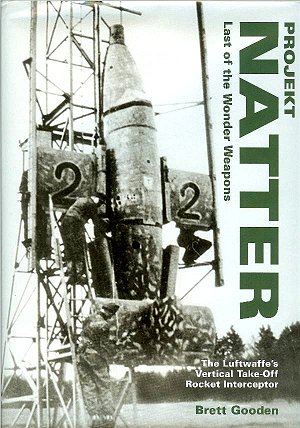|
Classic Publications |
|
|
|
Projekt Natter: Last of the
Wonder Weapons |
|
Reviewed By Floyd S. Werner, Jr. |
|
ISBN # 1-903223-62-8 |
|
One could argue that it is possible to judge a regime by the concern and care it shows for its subjects. By that standard (as with so many others), the Natter project serves to reveal how fundamentally flawed was the Nazi Third Reich. Few of the other so-called “wonder weapons” developed by the Germans at the end of World War Two convey the utter desperation and willingness to sacrifice any number of individuals in order to prolong the existence of Hitler’s regime. Conceived at the climax of the allied bombing campaign, the all wood Natter was a vertical take-off rocket powered interceptor designed to be launched in a matter of seconds to the height of an incoming bomber stream in order to salvo a payload of unguided rockets into their ranks. Following the attack, the Natter was designed to break apart with its valuable engine section preserved for subsequent launches by a parachute. Oh, the pilot got a parachute too and was intended to free fall back to earth after the engine and armament sections separated. This was after he attempted to ram the armament section into a bomber before ejecting just prior to impact. Clearly, being a Natter pilot was not the path to a long-term flying career. Brett Gooden’s book details the development and testing of this strange aircraft or anti-aircraft artillery, dependant on your point of view. Fortunately for the U.S. Army Air Force (and the Natter’s intended pilots), none of them were ever used operationally although a number of production models were captured at the end of the war and these are tracked since capture. This is a very authoritative text and though the concept sounds almost ludicrous in hindsight, the author clearly describes the numerous technical achievements that came as the result of this project. For example many people might be inclined to think that Yuri Gagarin was the first human to be launched into the air via rocket power. In fact, this honor fell to Lothar Sieber who ascended into the air in a Natter prototype on March 1, 1945. Sieber did not survive the flight. The development of the Natter project is well-presented accompanied by numerous photographs and illustrations in the usual Classic Publications style. Other innovations such as the launch mechanism and ejection system are also well described. This volume should have great interest for those interested in the final phase of the German defenses against aerial attack in World War Two as well as those interested in the historical antecedents of the space race and the anti- ballistic missile. I have to confess that although I personally found the story of this program interesting and was quite surprised at the number of technical obstacles overcome during it’s development, I couldn’t help but feel saddened that these breakthroughs came in the service of so terrible a regime with the morbid intention of almost certainly sacrificing one young life to take numerous others. Ready to be flown in combat, barely, the Natter never got the chance to show the effectiveness of the armament system or the concept of vertical takeoff disposable fighter. If you want to have the authoritative book on the Natter than look no further. The author’s passion is our gain in this comprehensive book of an airplane, or is it anti-aircraft artillery, whose time just didn’t come in time. It is available through Specialty Press at http://www.specialtypress.com or by calling 1-800-895-4585. A $4.95 shipping and handling charge is added. Thanks to Specialty Press for the review copy. Highly Recommended. |
|
Information, images, and all
other items placed electronically on this site |
